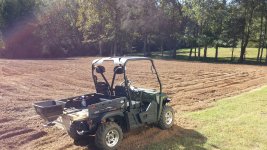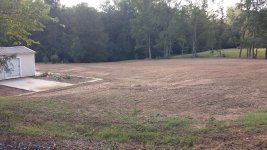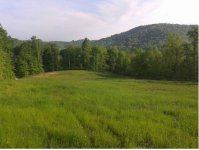Old Guy in Tenn
Silver Member
- Joined
- Feb 24, 2016
- Messages
- 127
- Location
- Claiborne County, TN
- Tractor
- LX4500 Yanmar 1948 Farmall Cub
We have 73 acres in NE Tennessee, mostly woods with about 7 acres cleared at the top of the hill. Last October we had our previously clear-cut field cleaned of stumps and assorted vegetation. It is looking good, and we want to avoid it growing back wild as it had done after originally being cleared. The weather report the day after the clean-up was for 1/2" of rain in each of the next 2 days. It had been a dry summer so, excited about the coming rain, we hurried to the co-op and purchased 300 lbs of grass and clover seed, as well as a powered spreader to mount on the neighbors ATV.
We headed home to Michigan, and the neighbor mixed and spread the seed that afternoon. The rain never came. You may recall that NE Tennessee caught fire a few weeks later, killing 14 people as it ravaged hundreds of bone-dry acres. The fire was put out by the downpour that finally arrived, over 6" in one day.
Anyway, our seeding was a failure. Very little sprouted because of the drought, then whatever was left washed away in the downpour. Bummer.
We will be seeding again soon, and want to do it right, so here I am asking for help. The ground has been bare over the winter, but is still fairly loose. It will be somewhat moist from the winter precipitation, and the spring rains should continue for many weeks after we seed. We would like to have the neighbor spread seed again, but would like it to grow this time. Will scattered seed be ok under those conditions? Does it need to be covered after spreading? How to cover it using the ATV?
Our tractor buy will be late this year or early next, so the neighbor is my only convenient option right now.
Thank you for your help.
- John
We headed home to Michigan, and the neighbor mixed and spread the seed that afternoon. The rain never came. You may recall that NE Tennessee caught fire a few weeks later, killing 14 people as it ravaged hundreds of bone-dry acres. The fire was put out by the downpour that finally arrived, over 6" in one day.
Anyway, our seeding was a failure. Very little sprouted because of the drought, then whatever was left washed away in the downpour. Bummer.
We will be seeding again soon, and want to do it right, so here I am asking for help. The ground has been bare over the winter, but is still fairly loose. It will be somewhat moist from the winter precipitation, and the spring rains should continue for many weeks after we seed. We would like to have the neighbor spread seed again, but would like it to grow this time. Will scattered seed be ok under those conditions? Does it need to be covered after spreading? How to cover it using the ATV?
Our tractor buy will be late this year or early next, so the neighbor is my only convenient option right now.
Thank you for your help.
- John



